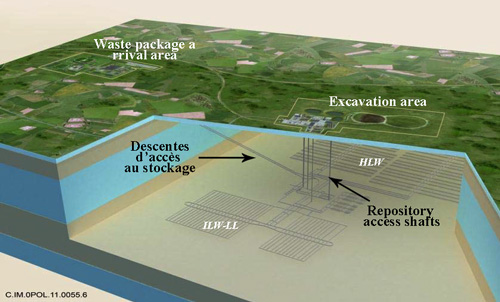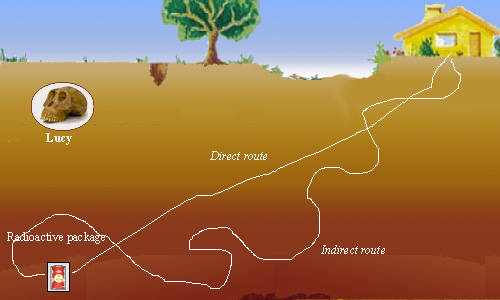A disposal of highly radioactive long-lived waste
Final disposal solutions exist for two of the five categories of radioactive waste: very low level waste and low- and intermediate-level short-lived waste, which together account for 90% of all waste by volume. It should be possible to find a solution for low-level long-lived waste. Attention therefore focuses on ultimate waste from the nuclear industry: high-level waste and intermediate-level long-lived waste, which are the most active and long-lasting categories, although only very small volumes are produced. The proposed solution is deep geological disposal in a purpose-built repository.
The containment barrier formed by a deep-lying geological formation combines with the two barriers respectively created by the waste package in which the radioactivity is confined and by the structure in which the waste package is placed. These barriers impede any migration by radioactive atoms. There is worldwide consensus regarding the need for such repositories at some point in the future. What types of ground are suitable for such repositories? How can we ensure that no radioactivity escapes for a very long time?

Deep repository operating principle
This diagram shows the layout of a hypothetical deep geological repository. High-level waste packages that release heat must be placed some distance apart. Intermediate-level waste (ILW) does not release heat and may therefore be arranged differently.
© ANDRA
In a geological repository, an underground rock layer serves, if not as a strong-box, at least as an obstacle to movement by such waste, which includes spent fuel assemblies and containers of vitrified waste. In the light of research conducted at an underground laboratory in Bure, France has opted for a 160 million year-old, 150 m thick layer of clay deep underground in the Paris Basin as the site for its CIGEO repository, on the boundary between the Meuse and Haute-Marne departments.
The harmfulness of radioactive atoms should not be exaggerated. Apart from one fleeting instant when they emit a ray, they behave like any other atom. Buried far beneath our feet, they would be no more likely to make their way to the light of day than an ordinary atom in the ground. In the absence of human activity, the only natural vector that might expose buried atoms is water.
Clay is notable not only for its plasticity but also for its ability to retain water that enters it. Water becomes trapped inside clay’s flake-based structure in thin films that have not moved since the clay formed during the tertiary or Mesozoic period. Due to this compartmentalised structure, there is almost no circulation of water. Atoms imprisoned within this structure move only very slowly. It would be an extremely long time before any buried atoms returned to the living world.

A very slow, uncertain return to surface
No water flows through the underground clay rock layer. Atoms trapped in this structure move only very slowly, hesitantly and in all directions. Radioactive atoms in a waste container will move in the same way as ordinary atoms. They should not travel any further than those of our ancestor Lucy, who has not moved for the past two or three million years. Any atoms that did rise to the surface would follow very variable routes and arrive at very different times.
© IN2P3
More than the scientific basis for such repositories, what will matter is what we place in them and when. ILW-LL waste could be buried immediately. In the case of high-level waste, the heat initially released is more problematic than its radioactivity. Because of this heat release, packages must either be spaced out or else allowed to cool prior to disposal. This is one of the reasons why such repositories are still at the project stage. In principle, the oldest waste will be buried first. Waste package designs is likely to change, to implement improvements arising out of ongoing research into high-level waste processing and conditioning.
Such issues deserve to be properly debated. Unfortunately, rational approaches to this debate are met with passion and in some cases wilful ignorance.
Julius Caesar is reputed to have called the Gauls undisciplined and quarrelsome. How would he have described their descendents, judging by the public debate organised in 2013 by France’s national commission for public debate (Commission nationale du débat public – CNDP) regarding the project for a deep geological repository in Lorraine (Centre Industriel de Stockage Géologique – CIGEO) developed by the national radioactive waste management agency (Agence nationale pour la gestion des déchets radioactifs – ANDRA)? Protesters opposed to the project prevented a debate’s kick-off meeting from being held in Bure on 23 May 2013. In the United States, the project to build the Yucca Mountain repository in tuff under the Nevada desert was abandoned. The site’s proximity to the gaming tables of Las Vegas was not the only reason for this; in particular, geologists voiced concerns due to the permeability of tuff.
If the CIGEO repository is built, France would be the first country to begin operating such a facility, in or around 2025. Only Sweden (2025) and Finland (2021) would be as advanced. Construction and opening dates in other countries are much further off: 2050 for Belgium, 2045 for Switzerland, 2048 for the USA, 2035 for Japan, and after 2035 and 2040 for Canada and China, respectively.
ANDRA video
– History of research into final disposal and the CIGEO project: view video
– Virtual tour of the research laboratory in Bure (the virtual tour provides an overview of the laboratory using real-life images, as well as an introduction to the research carried out there): view video..
Articles on the subject « Geological disposal »
CIGEO project
CIGEO – Overview of a planned repository The efforts made by engineers to ensure that highl[...]
Clay medium
The Callovo-Oxfordian argilite The geological stratum or ‘host rock’ that will[...]
Bure underground laboratory
A research laboratory for a disposal facility site Before high-level radioactive waste is buried [...]
Results on deep clay disposal
What we know about the disposal facility site In its final report in 2006 the French National Ass[...]
High-level waste repositories
Disposal of high-level waste packages The high-level waste packages requiring disposal will proba[...]
ILW-LL waste repositories
Filling an intermediate-level waste disposal cell Intermediate-level (ILW-LL) waste releases litt[...]
Waste disposal USA
Back to the drawing board after Yucca Mountain WIPP, the first deep geological repository to begi[...]
WIPP Project
The world’s first deep geological repository The United States is the first country in the [...]
Waste disposal Sweden
Sweden and Finland – Exemplary waste management Sweden probably features among the E[...]
Other countries
Shared challenges and similar solutions In most countries with nuclear industries, solutions for [...]